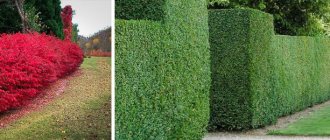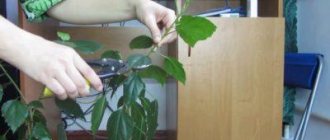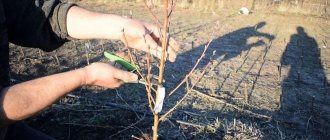Thuja is considered one of the most popular ornamental coniferous plants used in modern landscaping. Unpretentiousness in care and a wide variety of different forms and varieties make the culture popular both in the decoration of suburban areas and in the design of space in cities. To maintain the crown in a presentable form, the thuja is regularly trimmed.
In this article we will look at the types of pruning, its timing and the main rules that a gardener must adhere to when pruning thuja.
Depending on the purpose, there are two types of plant trimming:
- Sanitary – this removes dry and diseased branches;
- Molding - allows you to limit the growth of the crown and give the thuja a certain shape.
Note that in the majority, thujas independently form a crown in one form or another. It can be spherical, columnar or pyramidal. Formative pruning should be carried out in the following cases:
- If the gardener does not like the density of the crown;
- If there is a need to change the natural form to another.
Sanitary pruning is the main and mandatory procedure in the process of caring for thuja. It is carried out if there are dry and yellowed branches in the crown. Often, during sanitary pruning, branches damaged by pests and diseases are removed.
Thuja tolerates haircuts well - this procedure helps it achieve a noble shape and well-groomed appearance.
Pruning needs of different thuja varieties
In our latitudes, thuja occidentalis is most often planted - it thrives in severe frosts, high humidity and other unfavorable conditions. Depending on the variety, all plants need pruning - this is carried out according to the recommendations of specialists. In general, the intensity of pruning depends on the growth rate of the plants.
Below we will look at the pruning needs of the most popular varieties and their growth rates.
- Brabant is a variety that grows green mass by 35 centimeters in height and 15 centimeters in width per year. It is recommended to cut this type of thuja twice a year;
- Emerald is a variety that grows 10 centimeters in height and 5 cm in width per year. Pruning is carried out once a year;
- Columna is a plant that grows annually by 20 centimeters in height and 10 centimeters in width. Plants of this variety need to be trimmed twice a year;
- Holmstrup is a variety that grows 12 centimeters in height and 4 centimeters in width per year. Needs a haircut once a year;
- Wagner is a crop with an annual growth of 10 centimeters in height and 5 cm in width. Requires pruning once a year.
These varieties can naturally form into a column or pyramid shape. And if we talk about dwarf spherical varieties, then they grow even slower - they are cut even less often, while maintaining the normal sanitary condition of the crown.
Possible tree diseases and treatment methods
If the thuja brabant is not properly cared for, the tree is susceptible to attacks by pests and diseases. Let's start with the latter and tell you what they entail.
Diseases of thuja occidentalis Brabant:
- Late blight
With this fungal disease, the root system of the tree is completely destroyed. The needles turn gray and wither, and the trunk rots at the base. All this can happen to a thuja as a result of lack of drainage. As a result, water stagnates at the roots of the tree. It will no longer be possible to save the affected plant. Such a thuja should be dug up and replaced with an earthen lump at the place where it was planted. The only salvation from late blight is prevention. Thuja Brabant should be watered periodically with fungicides.
- Brown fungus
If in early spring you see yellowed scales on your thuja, this may be a sign of another disease - brown fungus. The cause of the disease is a lack of minerals in the soil. Simply put, you were “giving” the tree less fertilizer than it needed. Urgent action must be taken, otherwise the plant will die. First, cut off all affected shoots. Afterwards, do not forget to feed the thuja with fertilizers, and also spray the plant with a 2% solution of Fundozol once every 2 weeks.
- Rust and shutte
Most often, this fungus affects young thujas. The needles darken and then completely fall off. To avoid such consequences, every spring you need to treat thuja Brabant with Bordeaux mixture. If you forget to do this and the tree begins to fade, treat it with Fundozol.
Often the result of a wilted plant is an attack by parasites. Your evergreen tree can attack:
- Thuja false scale
It is very easy to recognize - yellow-brown “ulcers” appear on the bark of the tree. Gradually, this insect spreads throughout the entire trunk and eats away the bark. If you notice signs of a parasite on your Thuja Brabant, take action immediately. First, try to get rid of the pest mechanically. Just clean off the scabs with a knife or brush. Then treat the plant with insecticides. There is also a folk remedy - a soap-alcohol solution.
- Arborvitae moth
This small butterfly infects the thuja needles and they begin to turn brown. Insects gnaw passages in the scales. The tops of the tree shoots die off. If you notice these signs of disease on a thuja, treat the tree with pyrethroids.
- Thuja aphid
These small insects are covered in gray dust. They live in colonies and suck all the juices out of the tree. To get rid of the pest, spray the tree with Corbafos.
- Thuja beetle
This pest gnaws through the bark of a tree and lays eggs under it. The pine beetle can destroy your tree in a month. Gardeners don’t know how to deal with it. The only preventive measures known are treatment with insecticides.
Thuja Bryant haircut
Thuja variety Bryant tolerates both sanitary and shaping haircuts. It can be given any form - it all depends on the gardener’s imagination. Numerous experts advise pruning in June, when young growth is already clearly visible. In this case, it is imperative to remove diseased and dry branches and dilute the crown.
To form the crown, pinch the shoots by no more than a third.
Which is better: heated floors or radiators?
Warm floorBatteries
Required Tools
The success of the operation and the absence of negative consequences depend on the selected and processed instruments. Expensive mechanisms are not required. Thuja can be trimmed using standard garden tools. The main thing is that they are well sharpened and thoroughly disinfected. To disinfect equipment, it is permissible to use alcohol or a solution of potassium permanganate.
Softwood trimming tools:
- pruner;
- gardening scissors;
- hacksaw;
- hatchet;
- sickle.
On a note! The choice of a specific garden device depends on the amount of work and the thickness of the branches. The main thing is that it is convenient for the gardener, and there are no torn edges.
How to water thuja correctly
The need for cutting thuja directly depends on watering, because the plant, having the necessary moisture, grows more intensively.
Newly planted plants should be watered at least once a week. The soil in the tree trunk circle should not be allowed to dry out. The water consumption rate is from 10 to 50 liters for each plant (depending on the variety and size). Let us remind you that after watering it is necessary to loosen the soil to a depth of 8 to 10 centimeters (if deeper, you can damage the root system.
After this, the tree trunk circle needs to be mulched. For this you can use:
- peat;
- wood chips;
- compost;
- crushed bark.
In summer, when evaporation of moisture from the soil is greater, plants need more water. In hot weather, it is recommended to water every other day. In wet weather, reduce the number of waterings to once a week.
In autumn, thujas are watered before frost sets in.
Cone (or pyramid)
If you are new to topiary trimming and are afraid of not being able to cope with the first cutting of your thujas, start with the simplest shape - a cone. Its main advantage is the simplicity of the frame. As such, wooden slats with a height slightly higher than the bush are used.
If you want to achieve a cone shape, install a “hut” of three sticks around the thuja. If you want to get a pyramid, set it to five.
The main thing in this matter is to distribute the slats evenly around the circumference and connect them using wire or rope exactly above the central conductor of the bush.
Then everything is simple: using scissors, cut the thuja edge by edge, focusing on the stencil.
When the cutting is finished, the sticks are removed and the lower part of the trunk is slightly freed from the branches.
Then, using smaller scissors, trim the shape and adjust the top.
Do not try to shape the thuja into an inverted cone. In this case, the top will shade the lower part of the bush, and the sun simply will not reach there.
Thuja Brabant haircut
Thuja Brabant is a plant with a fast growth rate. Experts recommend forming the crown and carrying out sanitary pruning in the first year after planting. Thus, the plant will begin its growth and development in the required form.
A feature of pruning Thuja Brabant is that you cannot cut off more than 30% of the green mass at one time. It must be remembered that it is quite difficult for conifers to grow green mass on bare branches, so this should not be allowed when pruning. Otherwise, over-pruned branches will simply dry out.
We recommend cutting the shoots, maintaining a distance of 1 - 2 centimeters above the bud. And one more tip - do not forget to water the plant generously after cutting. Thus, the growth of green mass will occur more intensively.
If you decide to buy thuja for your garden plot, pay attention to the assortment of seedlings of different varieties in our online store “Plant Club”. We guarantee fast delivery of plants in plastic containers for roots to any city in Ukraine.
Features of the plant
Brabant is a human-bred variety of Western thuja. This conifer is evergreen, with particular resistance to the most unfavorable conditions and severe frosts. It is characterized by rapid growth. Over the course of a year, the plant grows up to 100 mm in width and up to 300 mm in height. Having reached 4 m, the conifer most often stops, although in natural conditions it can “gain” 20 m and even higher. The tree lives a long time. Its average lifespan is 120-150 years.
Ephedra is frost-resistant, tolerates frosts down to -35°C. Undemanding to soil, grows well in almost any soil mixture. True, on dense and heavy soils it is better to use drainage for the normal outflow of excess moisture. The plant is light-loving, but it is better to plant it in slightly shaded areas. Excessive ultraviolet radiation leads to burns of delicate needles. But the lack of light is also destructive. It will die in dense shade.
The ephedra is bright green, as can be seen in the photo. The color does not change when the seasons change. There is only one variety with a different shade. This is "Golden Brabant", a tree with yellow-golden needles. Under natural conditions, the crown is pyramidal in shape, but it can be shaped by proper pruning. A total of two are required per year, since the bush grows quickly. In dense plantings, growth in width stops and growth in height increases.
Instagram zel.ostrova
Instagram katya_landesign
- Landscape
Proper planting of thuja Smaragd in a summer cottage and tips for caring for the plant
Thuja Brabant haircut for beginners
Thuja occidentalis Brabant hedge is the most popular coniferous hedge. If you want your property to have a fence made of a neat green wall, then this thuja is an ideal option.
The big advantage of this variety is that it grows much faster than other varieties of thuja and can produce annual growth of up to 40 cm. And since this thuja grows faster than others, the price of a hedge made from it will be lower.
Thuja occidentalis Brabant is quite frost-resistant and can withstand temperatures down to 30 degrees. The only drawback: Brabant trees turn very brown in winter. A hedge of thuja western Smaragd, for example, will be brighter in winter.
Conditions of detention
When planning the placement of conifers in landscape design, two main planting conditions should be taken into account.
- Location. Thuja Brabant loves sunny meadows most of all. At the same time, Brabant takes root well in partially shaded areas. But it should be taken into account that in the shade the variety grows slowly and branches weakly.
- The soil. Prefers moist, well-drained, calcareous substrates with a pH of 6 to 7.5. However, the variety easily adapts to slightly acidic soil. The main thing is that the land was quite nutritious and rich in humus.
Why does a thuja hedge need to be trimmed?
Of course, the western thuja hedge must be trimmed. If this is not done, the tree will have a loose crown, grow up to 15 m, and become bare at the bottom. The fence won't work.
Before planting thuja for a hedge, you need to make a trench measuring 0.5 x 0.5 m. Fill the trench with fertile soil. Brabants are not picky about the type of soil, so loam and sandy loam are suitable. If the loam is very heavy, you will need to add sand or peat to it.
This is the color of the thuja occidentalis Brabant in winter
A trench should be made only if there is no deeply cultivated topsoil on the site. If you are planting a hedge of thuja in a place where there once was a vegetable garden, then there is no need to make a trench.
Distance between hedge plants in a row
The distance between plants is from 0.5 to 1 m. This distance depends on the quality and size of the planting material and how quickly you need to get a solid hedge.
If you buy thin thujas up to 1 m high, then the distance in the row is 0.5 m. If you buy thujas with a height of 1.5 m, fluffy and beautiful, then 1 m is possible. If you need to immediately get a dense hedge and do not intend to wait for it to grow, then buy two-meter thujas and plant them at a distance of 0.5 m . It is not recommended to make the distance between plants more than 1 m and less than 0.5 m.
Plant thujas along a stretched cord, each time measuring the distance from the previous plant with a tape measure. Even if you have a “diamond eye,” a cord and a tape measure are indispensable assistants when planting a thuja hedge.
The distance from the fence to the hedge can be from 0.5m to 1m. It depends on the build of the person who will trim the hedge. If you are not a small person and cannot walk between the fence and the thuja trunk at a distance of 0.5 m, then make this distance larger.
Maximum 1m.
If you can cut the hedge along the fence from the back side, then the distance between the fence and the hedge is 0.5 m.
In cross-section, the hedge should have the shape of a barely noticeable trapezoid
A hedge of thuja will not work if it is not formed. Immediately after planting, level the height and width of the plants along the entire length of the hedge, lightly trimming excess branches with pruning shears.
Formation
Thuja is widely used when planning landscaping in areas adjacent to the house; the culture is completely transformed after decorative manipulations.
You will be interested to know how to distinguish thuja from juniper.
The variety of shapes is impressive, the design options are inexhaustible, but all silhouettes will always come down to simple figures:
- Column;
- pyramid;
- cone;
- spiral;
- ball;
- cube
The makings of the variety will tell you the shapes that naturally fit into the garden. Experience plays an important role - hone your skills by cutting simple geometry. Keep in mind that a low-growing species cannot create a high hedge or a towering figure. Columnar varieties lend themselves to spiral cutting in compositions. Cones allow you to create arches or a shaped entrance to an alley with hedges.
When can you start forming
For a large-scale figure, wait until the tree’s 6th anniversary - then a powerful root system has already been formed, the thuja intensively grows its crown and can withstand stress more easily. It is useless to shape a small, loose bush, unless you decide to grow it on a frame. From the first days, monitor the number of trunks and the integrity of the future crown. Single cutting of branches that bristle is allowed and recommended.
Important! If the thuja is sick, do not subject it to a decorative haircut; it will only need sanitary pruning.
To create a dense row of hedges, trim the tops by about one-third, keeping the row straight. Next season, straighten the plants again - this stimulates an increase in lateral growth and compaction of the crown, and the thicker the bush, the better the coniferous barrier will look. If you like standard shapes, start shaping as soon as they reach the desired height. In this case, expose the trunk, leaving no stumps. Save the part of the top from which a cube, ball or other figure is formed.
Is it possible to cut off the top?
Thuja recovers quickly, so cut off the top without fear . Formative pruning involves trimming the upper branches to reduce height and create a silhouette. Correcting the direction of growth by removing the top at the desired level results in a horizontally growing tree.
If the splendor of the crown is important, the top of the central trunk is cut off . At the same time, the side shoots will receive more nutrition, and the crown will thicken. When creating low borders or high hedges, all plants must be the same height; for this, the overgrown tops are trimmed. Multi-trunk small seedlings tolerate the removal of several trunks well, after which the main one will quickly gain strength.
Cone
Thujas look great when trimmed into a smooth cone. Try your hand at the art of designer trimming, starting with this shape if you are the owner of Smaragd, Brabant, Konica or Holmstrup.
Important! An inverted cone only looks good for the first few days. Shading the wide top of the tapering bottom will completely deprive the tree of the sun, and the needles will die.
The principle of its creation is simple, and the result will exceed expectations:
- Take 3 wooden slats, 10 cm longer than the tree, for a frame that will help avoid distortions.
- Place each rail at an equal distance so that it fits snugly against the thuja, and all together form a “hut.”
- Tie the top of the boards together with twine above the center crown.
- Slowly trim the branches in the resulting window of edges.
- After adjustments on each side, remove the frame, align the lower part of the needles with the trunk, freeing them from branches.
- Using smaller scissors, trim the resulting cone and adjust the top.
Pyramid
To create a pyramid model, you don’t have to be a highly skilled craftsman. The varieties Smaragd, Holmstrup, Brabant require only minor adjustments in proportions; they have a naturally correct pyramidal shape.











